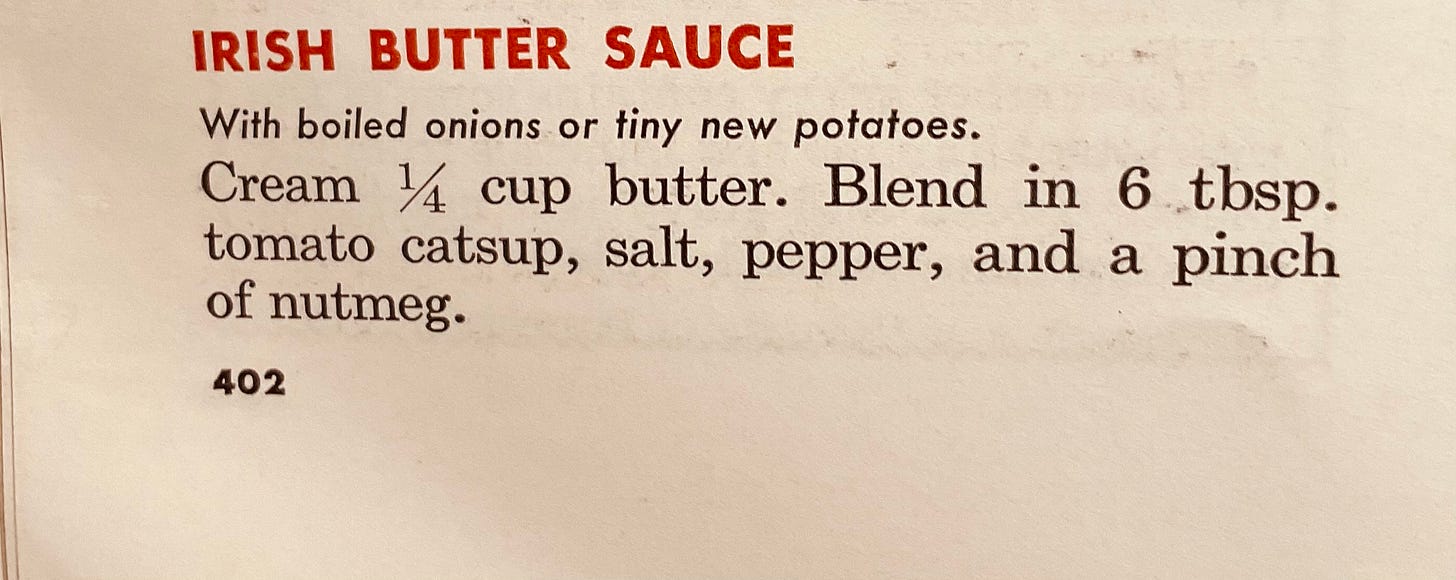Eating Irish: Ain’t It Awful?
Brunch & Pub Supper Recipes for the Dubious and Delighted
What would the leisure hours look like, if it weren’t for holiday parties, especially the less-ballyhooed fêtes of March?
You have Pi Day (yes, I’m going to a Pi Potluck) — and of course, St. Paddy’s Day, which is often relinquished to drinking.
The truth is, St. Patrick’s Saint day is an excellent occasion to break a fast like Lent, or eat until your belly pokes out of your pants!
I’m a book-learned cook. There are no “recipes handed down from my Grand.” I have to tell you, the idea in my maternal O'Halloran family that there was such a thing as “Irish cuisine” would‘ve generated a big laugh, or maybe a cold potato thrown at your head. 19th and 20th century Irish-American food lore is about food scarcity and drowning your troubles— not plates of delights. My mother and her sisters’ idea of a great meal was going out for Chop Suey in downtown Minneapolis.
My mom eventually learned how to cook, loosely, from a tome given to her by her friend Mary Lou Sullivan in 1958, The Betty Crocker Picture Cookbook.
Oh, what a laugh it is! This was a bestseller in its day, designed to sell as much Jello and ketchup to America’s post-war housewives as they could stomach.
Revised, enlarged, and SCORCHED. My mother’s copy from 1958. Everything is as awful as it looks.
Some of the recipe copy writing is just pure bull, concocted by what I imagine to be a sadistic queen high on diet-pill-speed and a corporate deadline.
Take, for example, this non-starter, “Irish Butter Sauce”:1
Do Not Under Any Circumstances Make This Nonsense: Butter with ketchup and nutmeg? COME ON.
I was a grown woman before I found out the real meaning of Irish native cuisine, and particularly Irish dairy, on my first trip to Belfast. I remember peering out the window of our plane from Boston, seeing the green pastures, the red and white-backed cattle, and thinking, “I come from California, but even our green isn’t like this!” —So vivid it made your eyes sting.
I checked into the Europa Hotel, famous in the city for surviving 33 bomb blasts. They were very good to me.
All over Ireland, the national identification with the US civil rights struggle and anti-apartheid movement, is ever-present. They don’t know where or why Americans lost their way . . .
The bellman carrying my bags urged me to catch breakfast, as if he was inviting me to a secret ball. Well, he was. I was so naively green myself, I didn’t understand his tip until I tasted the best butter, milk, and cream that ever came from the cow. A revelation.
Their butter is natively bright yellow, and even the cream has a warm color to it. It’s not “white.” I said to the server, “Is this real?” She indulgently laughed at me, even though she must hear this incredulity a dozen times a day.
I dreamed of packing my suitcase with that butter.
My Europa brunch carried on in the same splendor, each food group: The fried eggs sported stand-up yolks. The native honey was served in a big warm pot next the Irish oat porridge and a bottle of Bushmills. I put four different freshly ground juicy sausages on my platter.
Are you crying yet? You should be. The best eggs I ever had in my life, at the Europa hotel buffet.
My culinary hosts gave me a crash course on Irish farming, gathering and hunting history, and the beautiful poetry that describes the Irish palate, long before the potato ever came along.
Take the following poem from the 8th century: “The Hermit’s Song,” or “Marbán to Guaire.”
To what meals the woods invite me
All about!
There are water, herbs and cresses,
Salmon, trout.
A clutch of eggs, sweet mast and honey
Are my meat,
Heathberries and whortleberries for a sweet.
All that one could ask for comfort
Round me grows,
There are hips and haws and strawberries,
Nuts and sloes.
And when summer spreads its mantle
What a sight!
Marjoram and leeks and pignuts,
Juicy, bright.
Doesn’t it just put you in a mood?
I told my Belfast friends that if I showed them a copy of my Betty Crocker cookbook, it would confirm every ugly stereotype they have about Irish-Americans and bad taste.






